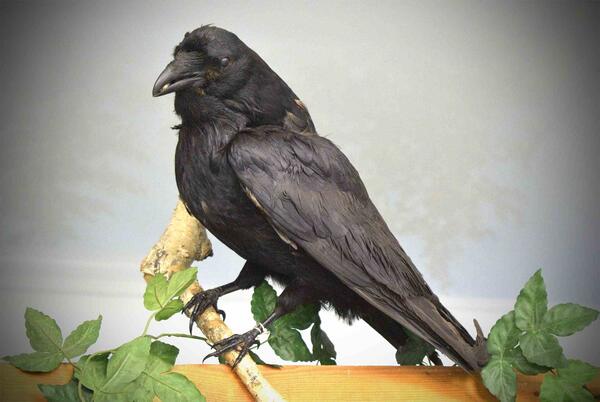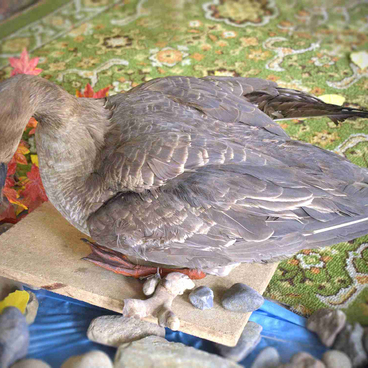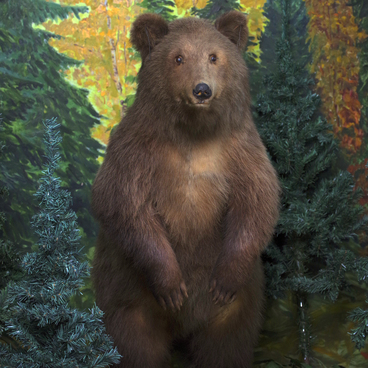The common raven is one of the largest passerine birds. Its body can reach 60 to 70 centimeters in length, the wingspan is 120—150 cm, while its weight ranges from 800 to 1,600 grams (or up to 2,000 g, according to some other estimates). Its calls are sharp and loud, and have a characteristic vibration to them. Aside from the easily recognizable gurgling croak, the bird can produce discrete, fairly complex sounds and even imitate voices of others. Its Russian name ‘voron’ comes form the word ‘voronoy’, which means jet black.
The female raven is smaller than the male, but aside from size, there are no other significant differences in appearance between them. Its beak is sharp, bulky-looking and very large. Another distinguishing characteristic of the common raven is its pointed, seemingly disheveled feathers on its neck, resembling a ‘beard’, which becomes especially noticeable when the bird is ‘singing’.
Adult ravens have a uniformly black plumage with a bluish hue. Their wings are long and tapered, while the tails are wedge-shaped. The claws of this bird are powerful, sharp and completely black in color. In the wild, common ravens can live up to 15 years of age. However, in captivity, owing to the absence of enemies and a stable diet, their lifespan increases to 40-50 years. These birds are not picky about food or climate, hence one can come across them anywhere.
Common ravens are omnivores and are often viewed as birds that clean up the environment. They usually feed on lizards, frogs, snakes, rodents, young offspring of other birds, large beetles and larvae. In addition, ravens readily consume different plants: grain and fruit bearing varieties.
These birds are highly intelligent and observant. Hence, they never take unnecessary risks. It can watch its prey or rivals for a long time, and when the time is right, claim its prize. Common ravens often hide any remaining food by storing it in the ground. In fact, digging items out of the ground or burying them is one of their favorite activities. It has been noted that they quite frequently use available objects around them to get their food.
In the wild, common ravens make faithful partners. Couples stay together for a long time. Both partners take part in the constriction of their nest. They usually build their abodes in a dense crown of a tall tree. The framework of the nest is comprised of thick branches that are woven together. Large holes are covered up with thinner twigs. Clay is often used as construction material. The inside of the nest is lined with a covering that also provides insulation. Its diameter can be over a meter. In the wild, the common raven’s main enemies are large birds of prey, such as eagles, hawks and Eurasian eagle owls.
The female raven is smaller than the male, but aside from size, there are no other significant differences in appearance between them. Its beak is sharp, bulky-looking and very large. Another distinguishing characteristic of the common raven is its pointed, seemingly disheveled feathers on its neck, resembling a ‘beard’, which becomes especially noticeable when the bird is ‘singing’.
Adult ravens have a uniformly black plumage with a bluish hue. Their wings are long and tapered, while the tails are wedge-shaped. The claws of this bird are powerful, sharp and completely black in color. In the wild, common ravens can live up to 15 years of age. However, in captivity, owing to the absence of enemies and a stable diet, their lifespan increases to 40-50 years. These birds are not picky about food or climate, hence one can come across them anywhere.
Common ravens are omnivores and are often viewed as birds that clean up the environment. They usually feed on lizards, frogs, snakes, rodents, young offspring of other birds, large beetles and larvae. In addition, ravens readily consume different plants: grain and fruit bearing varieties.
These birds are highly intelligent and observant. Hence, they never take unnecessary risks. It can watch its prey or rivals for a long time, and when the time is right, claim its prize. Common ravens often hide any remaining food by storing it in the ground. In fact, digging items out of the ground or burying them is one of their favorite activities. It has been noted that they quite frequently use available objects around them to get their food.
In the wild, common ravens make faithful partners. Couples stay together for a long time. Both partners take part in the constriction of their nest. They usually build their abodes in a dense crown of a tall tree. The framework of the nest is comprised of thick branches that are woven together. Large holes are covered up with thinner twigs. Clay is often used as construction material. The inside of the nest is lined with a covering that also provides insulation. Its diameter can be over a meter. In the wild, the common raven’s main enemies are large birds of prey, such as eagles, hawks and Eurasian eagle owls.



